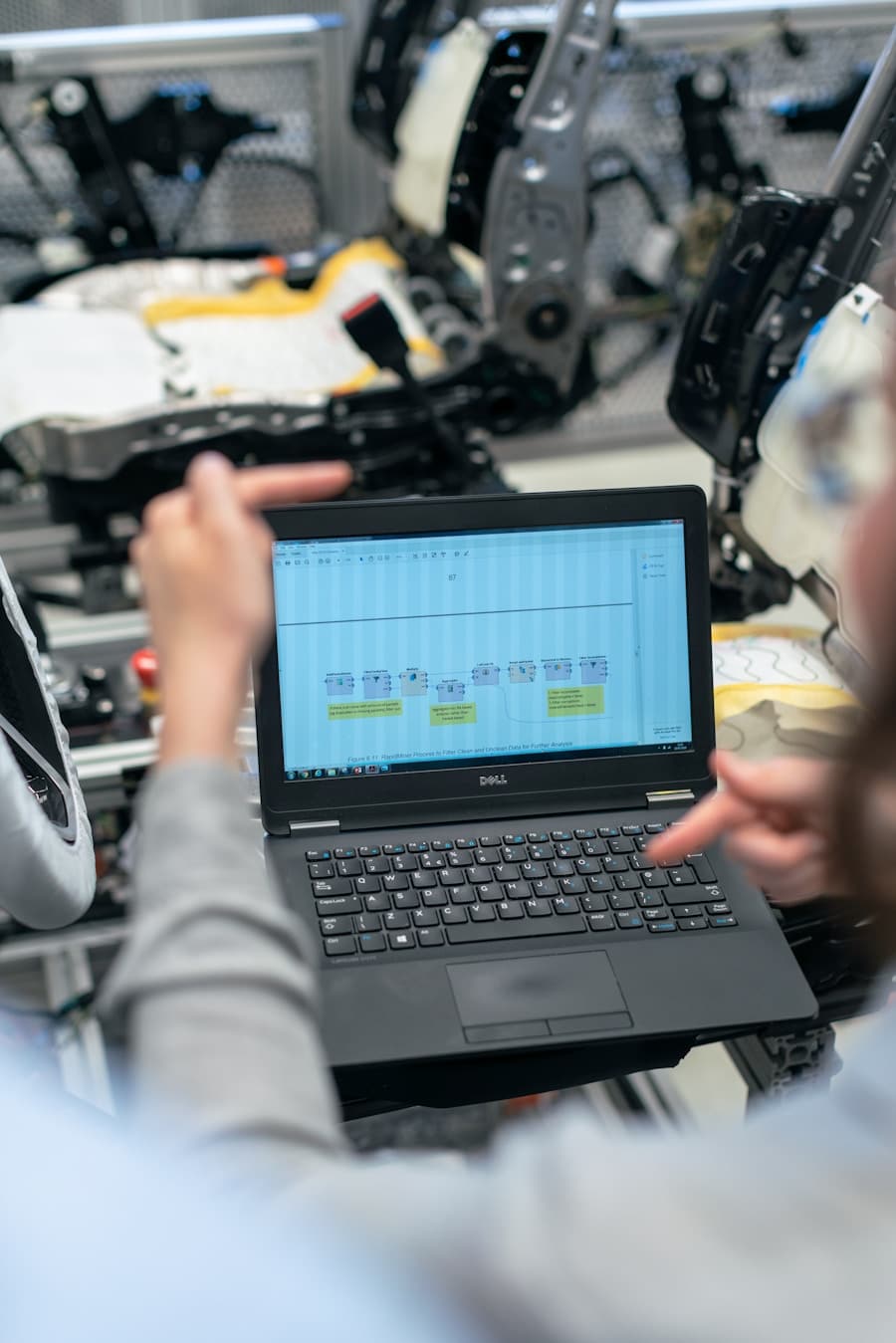Predictive maintenance software represents a transformative approach to asset management, leveraging advanced analytics and machine learning to forecast equipment failures before they occur. This proactive strategy contrasts sharply with traditional maintenance practices, which often rely on reactive measures or fixed schedules. By utilizing real-time data collected from machinery and equipment, predictive maintenance software can identify patterns and anomalies that signal potential issues.
This capability not only enhances operational efficiency but also extends the lifespan of assets, ultimately leading to significant cost savings. The evolution of predictive maintenance has been fueled by advancements in technology, particularly in the realms of the Internet of Things (IoT) and big data analytics. As sensors become more sophisticated and data collection more pervasive, organizations can harness vast amounts of information to make informed decisions about their maintenance strategies.
This shift from a reactive to a predictive mindset allows businesses to optimize their operations, reduce waste, and improve overall productivity.
Key Takeaways
- Predictive maintenance software helps in predicting equipment failures and scheduling maintenance activities proactively.
- It leads to cost savings and efficiency improvements by reducing unplanned downtime and optimizing maintenance schedules.
- The software increases equipment reliability and reduces downtime by identifying potential issues before they lead to breakdowns.
- It enhances safety and mitigates risks by ensuring that equipment is well-maintained and in optimal working condition.
- Improved asset management and inventory control are achieved through better tracking and monitoring of equipment and spare parts.
Cost Savings and Efficiency Improvements
Reducing Maintenance Costs
By predicting equipment failures before they occur, organizations can avoid the high costs associated with unplanned downtime and emergency repairs. For instance, a manufacturing plant can reduce its maintenance costs by up to 30% by addressing issues proactively rather than reactively. This not only minimizes the financial impact of equipment failure but also allows for better allocation of resources, as maintenance teams can focus on critical tasks rather than constantly responding to emergencies.
Improving Efficiency
Predictive maintenance software also leads to efficiency improvements by streamlining maintenance processes and reducing the frequency of unplanned outages. This enables organizations to enhance their overall productivity. For example, a transportation company can ensure that its fleet remains operational, thereby maximizing delivery schedules and minimizing delays. The software allows companies to schedule maintenance during off-peak hours, further optimizing resource utilization.
Fostering a Culture of Continuous Improvement
This strategic approach not only leads to cost savings but also fosters a culture of continuous improvement within the organization. By adopting predictive maintenance software, companies can create a proactive maintenance culture that prioritizes efficiency, productivity, and cost-effectiveness.
Increased Equipment Reliability and Reduced Downtime

The implementation of predictive maintenance software directly correlates with increased equipment reliability. By continuously monitoring the health of machinery and analyzing performance data, organizations can identify potential failures before they escalate into serious problems. For example, a power generation facility that employs predictive maintenance can monitor turbine performance in real-time, allowing operators to detect anomalies such as vibration or temperature fluctuations that may indicate impending failure.
This proactive monitoring ensures that equipment operates at peak efficiency, reducing the likelihood of unexpected breakdowns. Reduced downtime is another critical outcome of adopting predictive maintenance practices. In industries where equipment failure can lead to significant financial losses, such as manufacturing or energy production, minimizing downtime is paramount.
Predictive maintenance software enables organizations to schedule maintenance activities during planned outages or low-demand periods, ensuring that production schedules remain uninterrupted. A case in point is an automotive manufacturer that implemented predictive maintenance across its assembly lines, resulting in a 40% reduction in unplanned downtime.
Enhanced Safety and Risk Mitigation
Safety is a paramount concern in any industrial setting, and predictive maintenance software plays a crucial role in enhancing workplace safety. By identifying potential equipment failures before they occur, organizations can mitigate risks associated with machinery malfunctions. For instance, in the oil and gas industry, where equipment failure can have catastrophic consequences, predictive maintenance allows operators to monitor critical systems such as pressure valves and pumps continuously.
By addressing issues proactively, companies can prevent accidents that could endanger workers and lead to costly legal liabilities. Moreover, predictive maintenance contributes to a culture of safety within organizations. When employees see that their company is committed to maintaining equipment reliability and minimizing risks, it fosters a sense of trust and accountability.
Training programs can be developed around the insights gained from predictive maintenance data, empowering employees to recognize early warning signs and take appropriate action. This holistic approach not only enhances safety but also promotes a proactive mindset among staff members, ultimately leading to a safer working environment.
Improved Asset Management and Inventory Control
Effective asset management is critical for organizations seeking to maximize their return on investment in equipment and machinery. Predictive maintenance software provides valuable insights into asset performance, enabling organizations to make informed decisions about when to repair or replace equipment. By analyzing historical data and performance trends, businesses can develop a comprehensive understanding of their assets’ lifecycle, allowing for more strategic planning regarding capital expenditures.
In addition to improving asset management, predictive maintenance software enhances inventory control by ensuring that spare parts are available when needed without overstocking. For example, a facility that employs predictive maintenance can track the usage patterns of critical components and predict when replacements will be necessary based on historical data. This capability allows organizations to maintain optimal inventory levels, reducing carrying costs while ensuring that essential parts are readily available for scheduled maintenance activities.
The result is a more efficient supply chain that supports uninterrupted operations.
Integration with IoT and Big Data Analytics

Real-time Data Collection and Analysis
IoT sensors embedded in machinery collect real-time data on various parameters such as temperature, vibration, and pressure. This data is then transmitted to predictive maintenance software for analysis, enabling organizations to gain actionable insights into equipment health.
Enhanced Anomaly Detection and Pattern Identification
For instance, a manufacturing facility equipped with IoT sensors can monitor machine performance continuously, allowing for immediate detection of anomalies that may indicate potential failures. Big data analytics further enhances the effectiveness of predictive maintenance by enabling organizations to analyze vast amounts of data from multiple sources. By employing advanced algorithms and machine learning techniques, businesses can identify patterns and correlations that may not be immediately apparent through traditional analysis methods.
Data-Driven Decision Making and Operational Efficiency
For example, an aerospace company might analyze data from multiple aircraft engines to identify common failure modes and develop targeted maintenance strategies based on these insights. This level of integration not only improves the accuracy of predictions but also empowers organizations to make data-driven decisions that enhance operational efficiency.
Customizable Maintenance Scheduling and Workflows
One of the standout features of predictive maintenance software is its ability to offer customizable maintenance scheduling and workflows tailored to an organization’s specific needs. Unlike traditional maintenance approaches that often follow a one-size-fits-all model, predictive maintenance allows businesses to create schedules based on actual equipment conditions rather than arbitrary time intervals. This flexibility ensures that maintenance activities are performed only when necessary, optimizing resource allocation and minimizing unnecessary downtime.
For instance, a food processing plant may have different maintenance requirements for its various production lines based on their usage patterns and operational demands. Predictive maintenance software enables the plant manager to customize workflows for each line, ensuring that critical equipment receives attention when it shows signs of wear or degradation while allowing less critical machinery to operate without interruption. This level of customization not only enhances operational efficiency but also empowers organizations to respond dynamically to changing conditions in real-time.
Case Studies and Success Stories
Numerous organizations across various industries have successfully implemented predictive maintenance software with remarkable results. One notable example is Siemens Gas and Power, which utilized predictive analytics to enhance the reliability of its gas turbines used in power generation. By analyzing sensor data from turbines in real-time, Siemens was able to predict potential failures with high accuracy, resulting in a 20% reduction in unplanned outages and significant cost savings for their clients.
Another compelling case study comes from General Electric (GE), which integrated predictive maintenance into its aviation division. By leveraging data from aircraft engines equipped with IoT sensors, GE was able to predict engine performance issues before they occurred. This proactive approach not only improved engine reliability but also reduced operational costs for airlines by minimizing unscheduled maintenance events.
The success of GE’s initiative underscores the transformative potential of predictive maintenance across diverse sectors. These case studies illustrate how organizations can harness the power of predictive maintenance software to drive efficiency, reduce costs, and enhance overall operational performance. As more companies recognize the value of this technology, it is likely that we will see continued growth in its adoption across various industries, further solidifying its role as a cornerstone of modern asset management strategies.
If you are interested in learning more about technology and software solutions, you may also want to check out The Ultimate Guide to the Best Screen Recording Software in 2023. This article provides valuable insights into the top screen recording tools available in the market and how they can benefit users in various industries. Just like predictive maintenance software, screen recording software plays a crucial role in enhancing efficiency and productivity in different sectors.
FAQs
What is predictive maintenance software?
Predictive maintenance software is a tool that uses data analysis, machine learning, and AI to predict when equipment failure might occur. It helps industrial systems to identify potential issues before they happen, allowing for proactive maintenance and reducing downtime.
How does predictive maintenance software benefit industrial systems?
Predictive maintenance software benefits industrial systems by reducing unplanned downtime, extending the lifespan of equipment, optimizing maintenance schedules, and improving overall operational efficiency. It also helps in cost savings by avoiding unnecessary maintenance and minimizing the risk of catastrophic equipment failure.
What are the key features of predictive maintenance software?
Key features of predictive maintenance software include real-time monitoring of equipment, data analysis for identifying patterns and anomalies, predictive analytics for forecasting equipment failure, integration with existing industrial systems, and the ability to generate maintenance alerts and reports.
How does predictive maintenance software utilize data from industrial systems?
Predictive maintenance software utilizes data from industrial systems by collecting and analyzing information such as equipment performance, temperature, vibration, and other relevant metrics. This data is then used to identify patterns and trends that can indicate potential issues with the equipment.
What are the challenges of implementing predictive maintenance software in industrial systems?
Challenges of implementing predictive maintenance software in industrial systems include the need for accurate and reliable data, integration with existing systems, training personnel to use the software effectively, and ensuring that the software aligns with the specific needs of the industrial environment.

